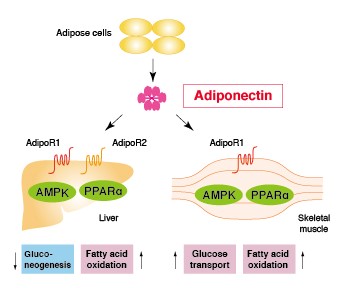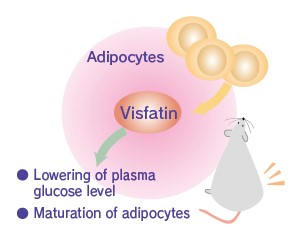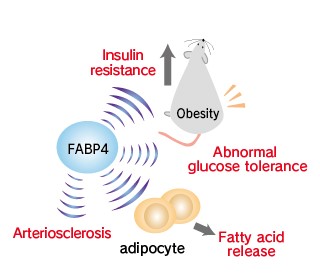Adipokine/Lipid metabolism
Click to view:
- Adiponectin
- Soluble LOX-1/OLR1
- RBP4
- Visfatin/PBEF and NAMPT
- AIM/CD5L/Spα
- FABP1/L-FABP
- FABP3/H-FABP
- FABP4/A-FABP
- FABP5/E-FABP/mal1
Adiponectin ELISA Kit
 A reduction in adiponectin serum levels is accompanied by insulin resistance states, such as obesity and type 2 diabetes mellitus. Increased adiponectin levels are associated with type 1 diabetes mellitus, anorexia nervosa and chronic renal failure. Adiponectin concentrations correlate negatively with glucose, insulin, triglyceride concentrations and body mass index and positively with high-density lipoprotein-cholesterol levels and insulin-stimulated glucose disposal.
A reduction in adiponectin serum levels is accompanied by insulin resistance states, such as obesity and type 2 diabetes mellitus. Increased adiponectin levels are associated with type 1 diabetes mellitus, anorexia nervosa and chronic renal failure. Adiponectin concentrations correlate negatively with glucose, insulin, triglyceride concentrations and body mass index and positively with high-density lipoprotein-cholesterol levels and insulin-stimulated glucose disposal.
Among two Adiponectin receptors AdipoR1 and AdipoR2, AdipoR2 is highly expressed in the liver. Through the two receptors, Adiponectin activates AMP-activated protein kinase (AMPK) and Peroxisome proliferator-activated receptor α (PPARα), which results in increase of fatty acid oxidation, glucose uptake and insulin sensitivity. Therefore, Adiponectin is regarded as a candidate for treatment of metabolic syndrome.
Related Products
Soluble LOX-1/OLR1 ELISA Kit
Lectin-like oxidized LDL receptor-1 (LOX-1), a 52-kD type II transmembrane receptor for oxidized low-density lipoproteins (ox-LDL) belonging to the C-type lectin family is present primarily on endothelial cells. Accumulating evidences indicate that oxLDL uptake through this receptor induces endothelial dysfunction. This receptor is expressed in the aortas of hypertensive, diabetic, and hyperlipidemic animals and is upregulated in early human atherosclerotic lesions. These results suggest that LOX-1 may be expressed locally and play important roles in atherogenesis by internalizing and degrading oxLDL and in inflammatory responses in vivo. LOX-1 can be cleaved from the cell surface and released as soluble LOX-1 (sLOX-1), and elevated sLOX-1 levels may be indicative of atherosclerotic plaque instability.
Related Product
|
Product
|
Product Code Number
|
|---|---|
|
CircuLex Human soluble LOX-1/OLR1 ELISA Kit
|
RBP4 ELISA Kit
Members of the lipocalin family, RBP4, FABP4 and NGAL (Lipocalin 2), which are produced from adipocytes, have recently been reported to play important roles in regulating systemic energy homeostasis, insulin sensitivity, and inflammation in animal models. Transgenic overexpression of RBP4 or injection of recombinant RBP4 in normal mice causes insulin resistance. Conversely, genetic deletion of RBP4 enhances insulin sensitivity. it was reported that serum RBP4 levels correlated with the magnitude of insulin resistance in human subjects with obesity, impaired glucose tolerance, or type 2 diabetes and in non-obese, non-diabetic subjects with a strong family history of type 2 diabetes. Elevated serum RBP4 was associated with components of the metabolic syndrome, including increased body mass index (BMI), waist-to-hip ratio, serum triglyceride levels, and systolic blood pressure and decreased high-density lipoprotein cholesterol levels. Adipocyte GLUT4 protein and serum RBP4 levels were inversely correlated.
Therefore, it is suggested that measurement of serum RBP4 levels is useful tool for the identification of insulin resistance before the development of diabetes and cardiovascular risk factors in subjects with varied clinical presentations.
Related Product
|
Product
|
Product Code Number
|
|---|---|
|
CircuLex Human RBP4 ELISA Kit
|
Visfatin/PBEF ELISA Kit
 Human obesity-related diabetes and the accompanying metabolic disorders have been specifically linked to increased visceral adipose tissue mass. Visfatin was identified as an adipokine predominantly expressed in and secreted from visceral adipose tissue in both humans and mice. This adipokine is also known as a growth factor for early B-cells called pre-B-cell colony-enhancing factor (PBEF) or nicotinamide phosphoribosyltransferase (NAMPT).
Human obesity-related diabetes and the accompanying metabolic disorders have been specifically linked to increased visceral adipose tissue mass. Visfatin was identified as an adipokine predominantly expressed in and secreted from visceral adipose tissue in both humans and mice. This adipokine is also known as a growth factor for early B-cells called pre-B-cell colony-enhancing factor (PBEF) or nicotinamide phosphoribosyltransferase (NAMPT).
It has been reported that despite visfatin does not include a known secretory signal, some visfatin is secreted from cell by inflammatory stimuli and functions as inflammatory cytokine itself. FK866, the specific visfatin inhibitor, has been reported to cause NAD+ depletion and induce apoptosis in various cancer cell lines, and is now developed as anti-cancer drug.
The visfatin inhibitor can also be a new candidate of antiinflammatory drug, since visfatin is reported to have proinflammatory effect.
Related Product
|
Product
|
Product Code Number
|
|---|---|
|
CircuLex Mouse Visfatin/PBEF ELISA Kit
|
AIM/CD5L/Spα ELISA Kit
AIM, also called CD5L/SPα, is a soluble 38 or 40-kDa glycoprotein expressed by macrophages present in lymphoid tissues (spleen, lymph node, thymus, and bone marrow). It belongs to the group B of the scavenger receptor cysteine-rich (SRCR) superfamily that includes the lymphocyte surface receptors CD5 and CD6 among others. AIM is able to bind to not only myelomonocytic and lymphoid cells, but also the surface of several Grampositive and Gram-negative bacterial strains, which suggests that it may play an important role in the regulation of the innate and adaptive immune systems.
It has been reported that AIM is incorporated into adipocytes via CD36 and inhibits the activity of fatty acid synthase (FAS), which results in decrease in lipid droplet size and adipocyte size.
Related Products
FABP1/L-FABP ELISA Kit
Fatty acid-binding proteins (FABPs) are a class of cytoplasmic proteins that bind long chain fatty acids. FABPs are small intracellular proteins (~13-14 kDa) with a high degree of tissue specificity. They are abundantly present in various cell types and play an important role in the intracellular utilization of fatty acids, transport and metabolism. There are at least nine distinct types of FABP, each showing a specific pattern of tissue expression.
Fatty acid binding protein 1 (FABP1/L-FABP), also known as liver-type FABP (L-FABP), is highly expressed in the liver and proximal small intestine where it is particularly important under fasting conditions. Increased amounts of FABP1/L-FABP are released into the serum during hepatitis, liver transplant rejection, and fibrate treatment. Therefore FABP1/L-FABP is thought to be a sensitive marker for cell damage of liver cells in vitro and in vivo. FABP1/L-FABP is also a marker for rapid hepatocyte lysis in vitro (as for example in toxicology assays) and for detection of liver damage during and after transplantation.
FABP3/H-FABP ELISA Kit
Fatty acid binding protein 3 (FABP3), also known as heart-type FABP (H-FABP), is highly expressed in heart and skeletal muscle. The level of FABP3/H-FABP was influenced by exercise, PPAR-α gonists and testosterone, and oscillates with circadian rhythm. In muscle cells, FABP3/H-FABP was involved in the uptake of fatty acids and their subsequent transport towards the mitochondrial β-oxidation system. Increased fatty-acid exposure in vitro and in vivo resulted in elevated FABP3/H-FABP expression.
FABP3/H-FABP was first shown to be released from injured myocardium in 1988, after which several studies investigated its application as a biochemical marker of myocardial injury. The FABP3/H-FABP isoform is produced not only in cardiomyocytes but also, to a lesser extent, in skeletal muscle, distal tubular cells of the kidney, specific parts of the brain, lactating mammary glands, and placenta. Recently, FABP3/H-FABP was shown to be a sensitive biomarker for assessing skeletal muscle toxicity in rats.
Related Product
|
Product
|
Product Code Number
|
|---|---|
|
CircuLex Mouse FABP3/H-FABP ELISA Kit
|
FABP4/A-FABP ELISA Kit
 Fatty acid binding protein 4 (FABP4), also designated aP2 and Adipocyte-specific fatty acid-binding protein (A-FABP), belongs to the fatty acid-binding protein super family whose members have relative molecular masses of –15, 000, and it is exclusively expressed in differentiated adipocytes. FABP4/A-FABP is a predominant cytosolic protein of mature adipocytes, accounting for –6 % of total cellular proteins.
Fatty acid binding protein 4 (FABP4), also designated aP2 and Adipocyte-specific fatty acid-binding protein (A-FABP), belongs to the fatty acid-binding protein super family whose members have relative molecular masses of –15, 000, and it is exclusively expressed in differentiated adipocytes. FABP4/A-FABP is a predominant cytosolic protein of mature adipocytes, accounting for –6 % of total cellular proteins.
This protein may be an important regulator of systemic insulin sensitivity and lipid and glucose metabolism. Mice deficient in FABP4/A-FABP are protected from development of hyperinsulinemia, hyperglycemia, and insulin resistance in the context of both dietary and genetic obesity. Adipocytes obtained from FABP4/A-FABP -null mice had markedly reduced efficiency of lipolysis in vivo and in vitro and exhibited a 2- to 3-fold decrease in fatty acid release, suggesting that FABP4/A-FABP mediates efflux of fatty acids in normal physiology. In apolipoprotein E-deficient mice, ablation of the FABP4/A-FABP gene conferred remarkable protection against atherosclerosis, which commonly occurs in this rat strain. By integrating metabolic and inflammatory pathways, FABP4/A-FABP provides a key link between various components of metabolic syndrome.
Related Products
FABP5/E-FABP/mal1 ELISA Kit
Human epidermal fatty acid binding protein (E-FABP, FABP5 and in mice called also mal1) belongs to the intracellular FABP family and is expressed in differentiated adipocytes, macrophages, skin, brain, mammary glands and so on. Mouse FABP5/E-FABP/mal1 has a high degree of homology to aP2 (mouse FABP4) and is also an important player in obesity-related disorders. FABP5/E-FABP/mal1 knockout mice exhibited enhanced insulin-stimulated glucose uptake and increased systemic insulin sensitivity, while transgenic overexpression of FABP5/E-FABP/mal1 aggravated insulin resistance and hyperglycaemia. Conversely, a marked compensatory up-regulation of adipocyte FABP5/E-FABP/mal1 expression was observed in FABP4/ aP2-deficient mice.
Related Product
|
Product
|
Product Code Number
|
|---|---|
|
CircuLex Mouse FABP5/E-FABP/mal1 ELISA Kit
|